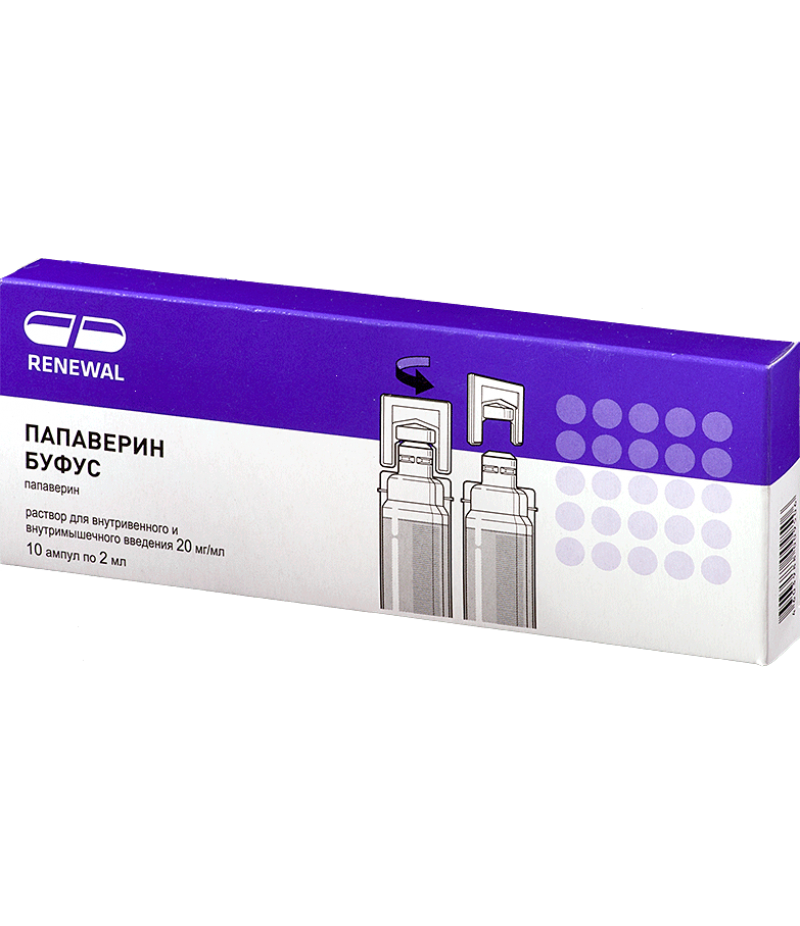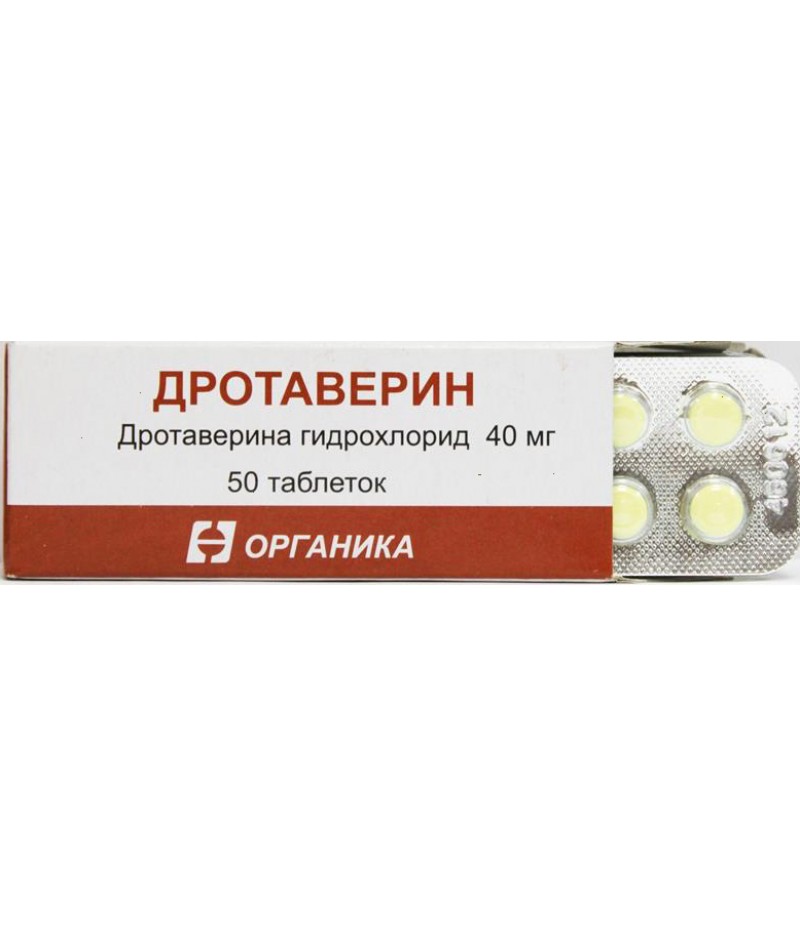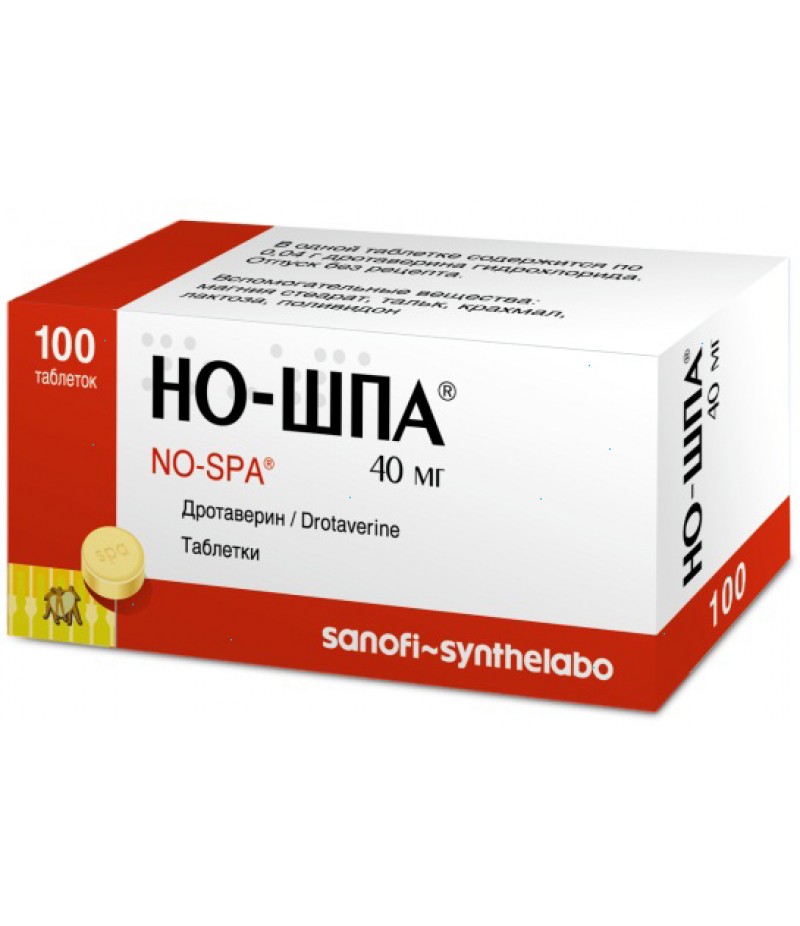Papaverine for injection 20mg/ml 2ml #10
- $6.59
- 3 or more $6.45
- 5 or more $6.30
- Availability:In Stock
Instruction for PapaverineYou can buy Papaverine on this pageCompositionInjection: Papaverinee hydrochloride - 20 mg per 1 ml of medicinal liquid; D, L-methionine; disodium ede..
Instruction for Papaverine
You can buy Papaverine on this page
Composition
Injection:
Papaverinee hydrochloride - 20 mg per 1 ml of medicinal liquid;
D, L-methionine;
disodium edetate;
water for injections.
Form of issue
Solution for injection 2% in ampoules of 2 ml. Cardboard packaging, as a rule, contains 10 pieces and instruction on the use of a pharmaceutical preparation.
pharmachologic effect
Papaverinea hydrochloride (Wikipedia indicates that the INN of the drug corresponds to the name of the main active component) is an opium alkaloid that affects smooth muscle cells and causes their relaxation, because the pharmacological group of the drug is defined as myotropic antispasmodics.
The mechanism of the therapeutic action of a biological substance is the effect of the transmission of muscle stimulation to the secondary messengers (messengers). Papaverine inhibits PDE (phosphodiesterase), due to which cAMP accumulates in the cell and the content of calcium ions decreases, in response to such biochemical changes, the smooth muscles of the internal organs (digestive tube, respiratory and genito-urinary systems and vascular bed) relax, their tone decreases .
Pharmacopoeia is a set of mandatory rules and official regulations that guide the manufacture, testing, storage and administration of medicines to patients. Since the main biologically active component of the pharmaceutical preparation is potent, for Papaverinee, the pharmacopoeia hydrochloride includes the following items for determining the authenticity of the chemical:
Physical characteristics - white crystalline powder odorless, with slightly bitter taste.
Solubility - dissolved in water for 40 hours, slightly soluble in 95% alcohol, soluble in chloroform and practically insoluble in ether.
Acidity of a 2% solution of Papaverinee hydrochloride is 3.0-4.5 (determined by the potentiometric method).
Chemical Authentication - 0.05 g of the pharmaceutical is placed in a porcelain bowl, moistened with a pair of high-concentration nitric acid droplets, after which yellow color should appear, which changes to orange when heated in a water bath.
The presence of organic impurities is a test for dissolving and changing the color in 5 ml of concentrated sulfuric acid.
Pharmacodynamics and pharmacokinetics
The active ingredient is quickly and almost completely absorbed by any means of administration of the drug into the body. Getting into the bloodstream, it binds to plasma proteins (90% of the total biologically active substance), so it easily passes through the histohematetic barriers. Biotransformation is exposed in the liver. The half-life is between 30 minutes and 2 hours, depending on the auxiliary components of the pharmaceutical preparation. It is mainly excreted by the kidneys in the form of metabolic products.
Indication for the use of Papaverine
spasm of smooth muscles of the abdominal cavity organs (especially often with cholecystitis, spastic colitis or pilorospasm);
hypertensive crisis (in combined conservative therapy);
renal colic;
endarteritis;
spasm of the peripheral vascular bed;
Reduction of the lumen of cerebral vessels due to a reduction in the muscular layer of the arteries;
angina pectoris;
bronchospasm;
reduction of arterial renal influx of vascular genesis;
retention of urine due to spasm of the urinary tract.
Indications for use also include the stage of premedication before operative surgical interventions in the abdominal cavity, proctological and urological manipulations. For what is used - relaxation of smooth muscle cells (for more details, see the paragraph "Pharmacological action").
Contraindications
intolerance of the constituent components of the drug;
violations of intracardiac conduction, especially atrio-ventricular block;
hypersensitivity to the pharmaceutical;
glaucoma;
severe hepatic impairment;
old age (since there is a significant risk of hyperthermia syndrome);
children age up to 6 months.
Additional restrictions to use (recommended only under the constant supervision of qualified medical personnel and regular diagnostic examinations):
recent craniocerebral trauma in the anamnesis;
chronic renal failure;
shock states;
hypothyroidism;
supraventricular tachycardia;
benign prostatic hyperplasia;
Insufficient functionality of the adrenal glands.
Side effects
From the cardiovascular system and blood: atrio-ventricular blockade, ventricular tachycardia, lowering blood pressure.
From the gastrointestinal tract: nausea, constipation (constipation), bloating, violation of the passage through the digestive tube, increased activity of liver transaminases.
Others: drowsiness, allergic reactions, eosinophilia.
Instructions for use Papaverine (Method and dosage)
How to use Papaverine Hydrochloride injection?
The active component of the pharmaceutical preparation has a high bioavailability, therefore, injections can be made, either subcutaneously and intramuscularly, or intravenously, the therapeutic possibilities of the drug will not suffer from this, and the end result will be just as strong. It should be determined, however, that the hypodermic injections of Papaverinee hydrochloride are recommended for use not in the distal part of the forearm, but in the shoulder or in the external surface of the thigh, since the frequency of administration can ensure the appearance of a hematoma. Intramuscular injections of Papaverine can be carried out according to the standard scheme, that is, use the upper lateral quadrant of the buttock.
Before the intravenous injections, the amount of the pharmaceutical preparation prescribed by the doctor should be diluted with 10-20 ml of isotonic sodium chloride solution. It should also be remembered that the administration of Papaverinee hydrochloride should be very slow, so as not to cause the patient unpleasant sensations during the injection.
Subcutaneously, as a rule, the contents of 1 ampoule (2 ml) of 2% solution of Papaverinee hydrochloride are introduced.
Dosage of the solution in ampoules for intravenous and intramuscular injection:
adults: single - 0.1 g, daily - 0.3;
children from 6 months to 1 year: single - 0.005 grams, daily - 0.01 g;
at the age of 2 years: single - 0.01 g, daily - 0.02 g;
3-4 years: single - 0.015 g, daily - 0.03 g;
5-6 years: single - 0,02 g, daily - 0,04 g;
7-9 years: single - 0,03 g, daily 0,06 g;
10-14 years: single - 0,06-0,06 g, daily - 0,1-0,2 g.
Dibazol with Papaverineom - how to use?
Dibazol is an antihypertensive drug from the group of peripheral vasodilators, that is, the active components of the pharmaceutical preparation have a vasodilating effect and contribute significantly to lowering blood pressure. Papaverinee has similar therapeutic properties with respect to the vascular system, because the combination of these drugs is actively used by emergency medical personnel to eliminate the hypertensive crisis.
Dibazolum with Papaverine is administered intramuscularly or intravenously, because in this way the necessary pharmacological effects of the active ingredients develop much faster than with oral or any other method of use. Relaxing influence of biologically active components can be combined with physiotherapeutic methods, for example, horizontal position with the lowered leg end, warm baths for legs, massage of the lower extremities and so on.
The dosage of Dibazolum and Papaverinee for the elimination of the hypertensive crisis is 3-5 ml of a 1% solution of Dibazol and 2 ml (the contents of 1 ampoule) of a 2% solution of the second pharmaceutical preparation. Such a large number of active ingredients allow not only to lower blood pressure, but also to stop feeling of nausea, pain in the heart and some other manifestations of cardiovascular pathology.
Overdose
Possible symptoms of intoxication with the active ingredients of the drug:
diplopia (double vision);
weakness;
lowering blood pressure;
drowsiness;
increased fatigue.
There is no specific pharmaceutical antidote, therefore detoxification therapy and symptomatic treatment are used. Especially effective is gastric lavage or the use of sorbents (milk, activated charcoal, for example) in the first hours after taking oral forms of Papaverine hydrochloride. Also, when an overdose of a drug is important to constantly monitor and, if necessary, artificially maintain blood pressure.
Interaction
Platyphylline is an antispasmodic, vasodilating, sedative, that is, by pharmacological abilities close to Papaverine. The drugs differ only in the mechanisms of therapeutic action, because Platifillin and Papaverinee are used in combined conservative sanation of spastic syndromes, hypertensive crises and other pathological conditions.
No-spa with Papaverine, like Platifillin, interact well, providing a synergistic therapeutic effect on the smooth muscle elements of the human body. This combination of pharmaceuticals is especially common in obstetric and gynecological hospitals with uterine tone, the threat of spontaneous miscarriage or overly active early labor.
In medical publications of neurological subjects, there are reports that the effectiveness of Levodopa is significantly reduced in combined conservative therapy, which Papaverinee in tablets or as a solution for injections against the background of medical sanation of Parkinson's disease is contraindicated.
The simultaneous use of Papaverinee with anticholinergic drugs may manifest itself in enhancing the therapeutic effects of the latter, therefore, if appropriate combined use should be discussed, reduce dosages or temporarily discontinue pharmaceuticals with a qualified specialist.
Storage conditions
In dry, sheltered from direct rays of sunlight, the temperature should not exceed 25 degrees Celsius in a tightly packed container. Pharmaceutical preparation belongs to list B, therefore, its storage should be carefully monitored.
Shelf life - 2 years.
special instructions
Papaverine hydrochloride significantly improves the peripheral circulation, which ensures the improvement of trophic processes in individual organs when it is used locally. This therapeutic ability causes the use of a pharmaceutical in bodybuilding. Practical observations of athletes show that it is most effective to use a medicament to increase the specific mass of the deltoid and biceps muscles.
The goal of athletes is the local impact on a certain part of the musculature, from which the injections are performed intramuscularly. The optimal dosage is 1-2 injections per week, which take place 15-20 minutes before intensive training. Further, at the very beginning of physical exercises, all efforts should be aimed at the "enriched" muscle, that is, engage in the system of "pumping" (pumping up blood), because the therapeutic effect of Papaverine for local use is short-lived.
The ingenuity and resourcefulness of the female half of humanity does not lag behind the stronger sex, because Papaverinee hydrochloride is used even in cosmetology procedures and home skin care. Due to the increased blood circulation of the peripheral parts of the body under the influence of the pharmaceutical preparation, the excretion of the accumulated fluid improves, the puffiness is eliminated and the metabolic processes are stimulated to some extent. Such therapeutic effects allow the use of the drug to fight cellulite, the elimination of an unpleasant "orange peel" in the buttocks and hamstring and even getting rid of a couple of extra pounds.
To obtain this result, leading cosmetologists recommend using wrapping with caffeine and Papaverinee, which can be performed even at home. To prepare a miracle mixture, you need 2 ampoules of Caffeine benzoate 2 ml each, 2 ampoules of Papaverinee hydrochloride 2 ml each, and a small amount of unsweated honey. Before applying the cosmetic, you should prepare the skin, for which light peeling, scrub or a small local massage is used.
The mixture should be applied evenly over the entire area of the treated surface with a small layer. At once the cosmetic means will not be absorbed, therefore it is necessary to cover the skin closely with polyethylene film (for this purpose the food film is ideally suited) and warm, wrapped in a quilt or with the help of winter clothes. It is recommended to wrap for at least an hour, then rinse the rest of the mixture with warm water and apply a moisturizing or nourishing cream. The duration of the course is twelve procedures, and the frequency of their course is every other day.
The active ingredients of the pharmaceutical drug spread their beneficial effects not only to humans, but also to animals, because Papaverine has found wide application in veterinary practice. Especially often the drug is used for cats, as pets are taken to hospitals due to spasms of smooth muscles of the intestine. The etiological factor is the hygienic procedures of the felines, because in the process of "washing", as a rule, some amount of wool is ingested. Papaverinee facilitates the removal of the contents of the digestive tube.
Children
Papaverine hydrochloride is actively used in pediatric practice, starting at the age of 6 months.
Papaverine in pregnancy and lactation
Why candles Papaverine during pregnancy?
Uterus, the organ of the female reproductive system, in which the intrauterine phase of fetal development takes place, has in its composition both transversely striated musculature and smooth muscles. In the process of bearing a child often develops an increased tone of the body, resulting in possible spasmodic pains, early contractions, premature discharge of amniotic fluid and birth not at the planned time. Papaverinee hydrochloride has a relaxing effect, which allows you to remove the above manifestations of uterine hypertension.
Of course, before using the drug should determine the pharmaceutical form, which will have the most favorable effects and will not harm the developing organism of the child and mother. For pregnant women, the usefulness of using one form or another of Papaverine is determined by the duration of gestation, for example, oral tablets are recommended at early stages, and at later times, intramuscular and subcutaneous injection of injections is much better.
Candles with Papaverine during pregnancy
First of all, it is necessary to decide on a completely logical question for patients - where to insert the suppositories of Papaverine during pregnancy, in fact, as a rule, this pharmaceutical form of the drug is used rectally, but the therapeutic effect is required not in the final sections of the gastrointestinal tract, but in the muscular elements of the genitourinary tract system. This misconception is characteristic of women who are completely unfamiliar with the principle of the work of local pharmaceutical suppositories.
After the administration of Papaverinee, the active ingredients of the suppositories are actively absorbed and disseminated first by local blood flow to nearby organs, so that the smooth muscle elements of the uterus are supplied with biologically active substances in full. Another positive point in the use of this pharmaceutical form is the high bioavailability of rectal suppositories, that is, a large percentage of the drug enters the microcirculatory bed, and is not excreted with metabolites outside.
Pricks during pregnancy
Of course, the most effective way of using Papaverinee hydrochloride is its intramuscular or even intravenous administration, because in this way the bioavailability of the drug tends to be maximum, and the concentration of the active substance remains at the highest point for the longest period of time.
It should be emphasized that the injection form of the pharmaceutical preparation is especially relevant in late pregnancy, when uterine hypertension or spastic, cramping pain can lead to premature onset of labor and the release of amniotic fluid. If there are appropriate indications from the attending physician, it is worthwhile to think about inpatient treatment, because in this case the pregnant woman will be under the constant supervision of medical personnel, which can not but inspire confidence.
The dosage of the solution for injection, as well as the frequency of use of the pharmaceutical preparation, is selected individually, as a rule, it ranges from 1 to 10 ml of 2% of the drug 2-4 times a day. If adverse consequences of conservative sanation occur, you should immediately contact a qualified specialist.
Papaverine hydrochloride tablets, instructions for pregnancy
Since special medical knowledge and skills are required for injection of a pharmaceutical preparation, and rectal suppositories can cause certain inconveniences and unpleasant sensations during their use, often these pharmaceutical forms of Papaverine are replaced with tablets that are administered orally. Of course, the effectiveness of such conservative therapy is slightly lower than that of other ways of introducing the active ingredient into the body, however, from the daily use of tablets, there are no equal.
Papaverinee hydrochloride in oral form is used exclusively by indications, and the criterion for its use is the subjective state of health of the pregnant woman, therefore there is no strict dosage of the pharmaceutical preparation. Specialists in obstetrics and gynecology do not recommend taking more than 4 tablets per day, which should be used 2 hours before meals, in order to increase the pharmacokinetic ability of the active ingredient.
Reviews about Papaverine
Reviews about the pharmaceutical product can be found in various forums and online resources, because a wide range of therapeutic action of the biologically active component allows you to evaluate its effectiveness by a large category of patients in different departments and with various diseases.
For example, the drug has acquired a positive reputation in proctologists and their patients, since Papaverinee hydrochloride is used as a symptomatic conservative treatment for hemorrhoids, one of the most pressing problems of our time. The use of a pharmaceutical preparation in the form of rectal suppositories allows to facilitate the act of defecation, partly to stop the pain syndrome, to eliminate the problem of bleeding from the enlarged hemorrhoids, which can not but be noted in the recommendations on thematic sites.
On the other hand, it is possible to observe positive responses about the candles of Papaverine during pregnancy, since the antispasmodic and relaxing properties of the active ingredient effectively stop the problem of hypertension of the uterus, which eliminates the threat of premature birth. Biologically active substance makes it easier to grasp the pain that accompanies the last weeks and days of bearing a child. Also, the pharmaceutical preparation is used for preventive purposes in obstetric hospitals.



